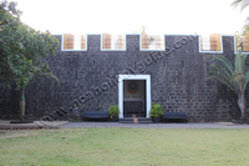Portuguese rule in Goa
The arrival of the Portuguese to India
The advent of portuguese rule in Goa began in 1498, when Vasco da Gama rounded the Cape of Good Hope and landed at Calicut marking the advent of European into India. The Portuguese arrived as Merchants with the intention of setting up a colony and therefore gaining control of the spice trade from other European powers after all other land routes to India had been closed by the Ottoman Turks.Pictures of Goa during Portuguese rule
The conquest of Goa by the Portuguese
In 1510, Portuguese admiral Afonso de Albuquerque attacked Goa at the behest of the local chieftain Thimayya. After losing the city briefly to its former ruler, Ismail Adil Shah, the Muslim king of Bijapur, Albuquerque returned in force only three months later, on November 25, with a fully renovated fleet.In less than a day they took possession of Goa from Ismail Adil Shah and his Ottoman allies, who surrendered on 10 December. The Chapel of St. Catherine, was built during the Portuguese on the day of their victory over Adil Shah. Albuquerque and his successors left almost untouched the customs and constitutions of the thirty village communities on the island, only abolishing the rite of sati (widow-burning).
Conversion to Christianity
Jesuit missionaries, such as the Basque Francis Xavier, followed the Portuguese to spread Roman Catholic Christianity to Asia with mixed success. In 1542 Jesuit missionary Francis Xavier arrived in Goa at the service of King John III of Portugal. St. Francis Xavier mentions the architectural splendor of the city; but it reached the climax of its prosperity between 1575 and 1625. Travellers marveled at Goa Dourada, or Golden Goa, and there was a Portuguese proverb, He who has seen Goa need not see Lisbon.Around 1583, missionary activity in Cuncolim led first to small skirmishes and finally to the murder of all the missionaries. The Portuguese authorities called the 16 chieftains of each ward. (vado) of the Cuncolim village to the Assolna fort, ostensibly to form a peace pact with the villagers. At the fort, the chieftains were slain, except for two who jumped from the fort into the Arabian sea and presumably swam to Karwar. The villagers were left without their traditional leaders and the Portuguese began confiscating the land of the locals and set up the Goa Inquisition.
By the year 1560 leading up to 1812 many local residents were converted to Christianity by missionaries. Many churches were built which do stand tall in all their glory and splendor even today. The distinct Portuguese names that many Christian goans bear till date are a relic of the time when natives were forced to adopt a Portuguese name at the time of conversion.
Rebellions During Portuguese Rule
Maratha troops entered parts of Bicholim in 1641 and began the minor Bicholim conflict, which ended in peace treaty between the Portuguese and Maratha Empire. In 1787, there was a rebellion started by some priests against Portuguese rule. It became famous as the Conspiracy of the Pintos.Post 18th century Goa was peaceful and Portuguese rule brought prosperity and stability to the region. In the 19th century, there was a movement for independence in India, the effects of which were felt on a smaller scale in Goa. Goan participated in satyagraha in the late 1940's. After India got its independence, the Portuguese refused to give up their hold over Goa. Finally on Dec 19, 1964 India conquered Goa from the Portuguese and Goa became a part of India.





No comments:
Post a Comment